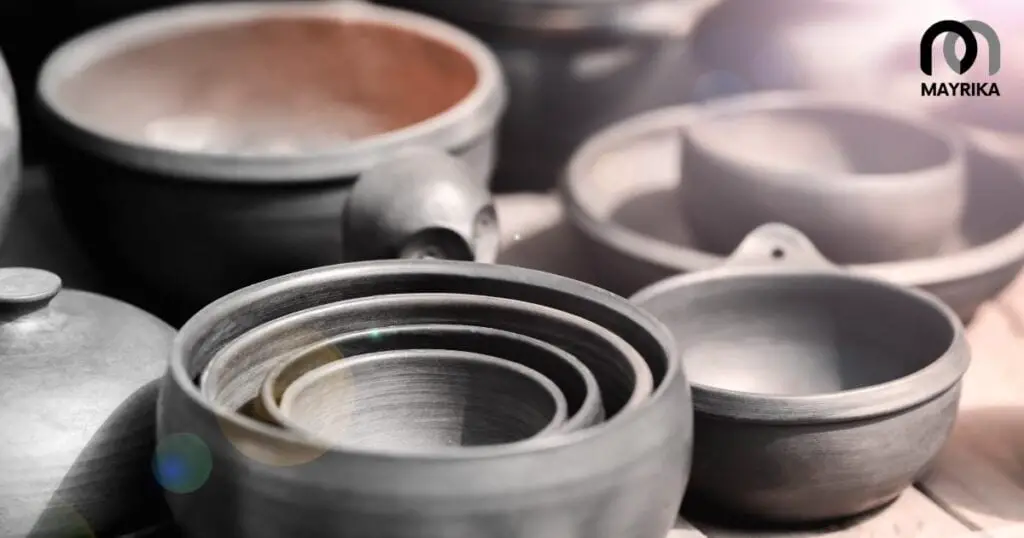Clay cookware is an important kitchen staple in many homes. It is beautiful and durable, but it can also be difficult to clean.
This article will provide some tips on how to clean your clay cookware so that it looks its best.
Clay cookware is made from natural materials and is typically unglazed. This means that it is porous and can absorb flavors and odors from food.
What is Clay Cookware?
Clay cookware has been around for centuries and is still used today in many parts of the world. It is made from clay that is fired in a kiln to harden it.
The clay used to make cookware can vary in color, depending on the type of clay and the minerals that are found in it.
Clay cookware is non-reactive, which means it does not absorb flavors or odors from food.
It is also oven-safe and can be used on all types of cooking surfaces, including gas and electric stoves.
Clay cookware conducts heat evenly, so food cooked in it will be evenly cooked.
One downside of clay cookware is that it is fragile and can break easily if dropped or mishandled. It should be washed by hand and not put in the dishwasher.

What are the Benefits of Using Clay Cookware?
Clay cookware has been used for centuries and is still a popular choice for many people.
There are many benefits to using clay cookware, including its ability to evenly distribute heat, its natural non-stick properties, and its durability.
Clay cookware is a great choice for those who want to evenly distribute heat while cooking. This is because clay is a very good conductor of heat.
Clay cookware is also a natural non-stick material, so you won’t have to worry about your food sticking to the pan.
Additionally, clay cookware is very durable and will last for years with proper care.
How to Clean Clay Cookware
Clay cookware is a great option for those who want to avoid using non-stick cookware.
However, it can be a bit tricky to clean, since you can’t use harsh chemicals or scrubbing pads.
Here are a few tips for cleaning your clay cookware:
- Soak the cookware in warm water for a few minutes before washing. This will help loosen any food that is stuck.
- Use a soft sponge or cloth to wash the cookware. Avoid using anything abrasive, as this can damage the clay.
- Rinse the cookware well after washing.
- If there are any stubborn spots, you can try making a paste of baking soda and water.
Apply the paste to the spots and let it sit for a few minutes before washing off.

What Kinds of Foods Can You Cook in Clay Cookware?
Clay cookware has been around for centuries and is still being used today in many parts of the world. It is made from clay that is fired in a kiln and then glazed.
Clay cookware can be used to cook many different kinds of food. One of the most popular uses for clay pots is to make stews and soups. Clay pots can also be used to bake bread and cakes.
Clay pots are very versatile and can be used to cook almost any kind of food. They are especially good for slow cooking because they help to retain moisture and flavors.
What are the Important Tips to be Kept in Mind While Cleaning Clay Cookware
When it comes to cleaning clay cookware, there are a few important tips to keep in mind.
First and foremost, it’s important to avoid using harsh chemicals or abrasive scrubbers. This can damage the delicate clay surface and lead to cracking or chipping.
Instead, stick to mild soaps and gentle scrubbing pads. It’s also important to avoid exposing the cookware to sudden temperature changes.
This can cause the clay to crack or break. So, be sure to let the cookware cool down before washing it in cold water.
Finally, be sure to dry the cookware thoroughly after washing it. Otherwise, you may end up with water spots or streaks on the surface.
By following these simple tips, you can keep your clay cookware looking new for years to come!
FAQs
-
Can clay pots be reused for cooking?
Cooking with clay pots is a tradition that dates back centuries. Clay pots are made from natural materials and are safe to use for cooking.
Clay pots can be reused for cooking, but there are some things to keep in mind when doing so.
When cooking with clay pots, it’s important to soak the pot in water for at least an hour before using it.
This will help prevent the pot from cracking when exposed to heat.
It’s also important to avoid sudden temperature changes when cooking with clay pots.
For example, don’t put a hot pot on a cold surface or vice versa.
Clay pots can be used for both stovetop and oven cooking.When using a clay pot on the stovetop, it’s best to use a low heat setting to prevent the pot from cracking.
-
How do you clean reused clay pots?
If you’re like most people, you probably have a few clay pots lying around your house.
Maybe you’ve had them for years, or maybe you just bought them at a garage sale.
Either way, if you’re going to use them again, you’ll need to clean them first.
Here’s how to do it:
Start by rinsing the pot with warm water. This will remove any dirt or debris that’s on the surface.
Next, fill the pot with warm water and add a tablespoon of dish soap. Use a sponge or brush to scrub the inside and outside of the pot.
Rinse the pot again with warm water to remove the soap.
Finally, place the pot in a sunny spot and let it air dry completely before using it again.
-
What can you do with old clay pots?
If you have old clay pots lying around, don’t throw them away! There are plenty of ways to reuse them.
One idea is to plant flowers in them. You can either put one large plant in each pot or divide the pot into sections with different kinds of plants.
Another option is to use the pots as planters for herbs or vegetables.
Old clay pots can also be used as decoration around the house. Paint them or add stickers to personalize them.
Or, fill them with candles and arrange them on a table or shelf. There are endless possibilities for what you can do with old clay pots!
-
Why are some clay pots black?
Clay pots are a type of container that is often used for plants or cooking.
They are made from a variety of materials, including clay, ceramic, and porcelain.
Clay pots come in a variety of colors, including white, black, brown, and red.
Clay pots are usually black because they have been burned in a kiln.
The high temperatures in the kiln cause the clay to change color. The change in color is permanent and cannot be reversed.
Some people prefer to use black clay pots because they believe that the pot helps to absorb heat from the sun.
This can help to keep plants warm during cooler months. Black clay pots can also add an elegant touch to any garden or home décor.
-
Can clay pots go in the dishwasher?
Clay pots are made of a porous material that is not conducive to withstanding high temperatures and water pressure.
The dishwasher cycle typically uses water that is between 140-160 degrees Fahrenheit and significantly high water pressure, which can cause the clay pot to break.
In addition, the detergent used in the dishwasher can also be harsh on the clay pot and cause it to degrade over time.
For these reasons, it is not recommended to put clay pots in the dishwasher.
-
Can you put clay pots in the oven?
Clay pots are a type of earthenware that is popular in cooking, especially for slow-cooked dishes.
They are often used in conjunction with a lid to create a tight seal, trapping steam inside and ensuring that flavors meld together. But can you put clay pots in the oven?
The short answer is yes, you can put clay pots in the oven. However, there are some things you need to keep in mind.
First of all, make sure that your pot is oven-safe.
Some clay pots are not meant to withstand high temperatures and may crack or break if placed in the oven.
Second, be aware that the pot will absorb heat from the oven, so it’s important to start with a preheated pot and use caution when handling it after cooking.
Clay pots are made of a material that is porous and absorbs water.
When heated, the water inside the clay pot turns to steam and can cause the pot to crack or break.
For this reason, it’s not advisable to put clay pots in the oven.
-
What are the advantages of cooking in clay pots?
Clay pots are one of the oldest and most versatile cooking vessels in existence. They can be used for baking, roasting, simmering, steaming, and even deep-frying.
While modern cookware has largely replaced clay pots in Western kitchens, they are still widely used in Asia, Africa, and Latin America.
There are several advantages to cooking in a clay pot. Clay is an excellent conductor of heat, so it evenly distributes heat throughout the pot.
This makes it ideal for slow-cooking dishes like stews and casseroles.
Clay pots also help to retain moisture, making them perfect for cooking dry or tough cuts of meat.
-
Can clay pots be used on an induction stove?
Clay pots are not typically used on induction stoves because they are not made of ferrous material.
Induction stoves work by using a magnetic field to create heat, and since clay pots are not magnetic, they will not work with this type of stove.
There are some clay pots that have a ferrous coating, which would make them compatible with an induction stove, but these are not as common.
Conclusion
First and foremost, never soak the clay cookware for long to remove stubborn stains.
If you are using a stain remover that is phosphate-free, then it can be used as per usual but just make sure that you don’t use it more than once since there may be some health risks associated with it.
Instead, opt for a natural clay cleaner like baking soda mixed in hot water and apply carefully with a cloth.
This will not damage your favorite pot and give you years of maintenance-free use!
